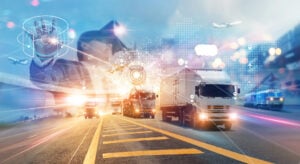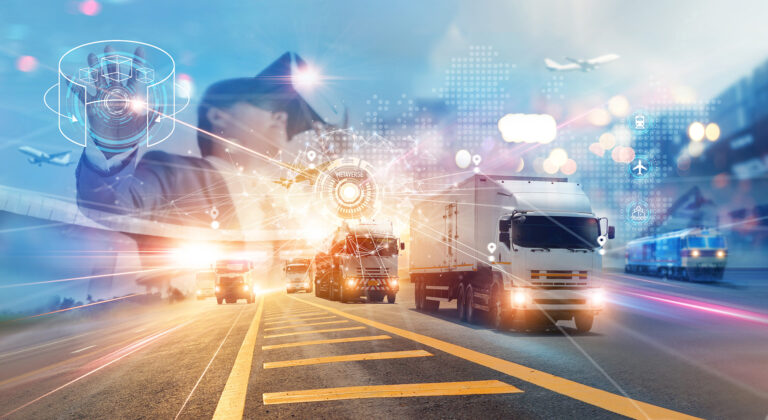In the tech industry, the Metaverse is considered the next big thing. Critics will say it will never catch on. In the Metaverse, people will use digital avatars to work, shop and even travel the world. Sound like science fiction? In some ways, it is. Too far-fetched for logistics? That’s exactly what we want to discuss in this article.
It started with a thought…
If, according to Buddhist wisdom, everything begins with a thought, then the metaverse has been around for about 30 years. The term, an allusion to the prefix meta and the “verse” in Universe, first appeared in Neal Stephenson’s “Snow Crash”, a cyberpunk novel from the early 1990s. The story is set in a bleak dystopian future in which the state has withdrawn from all important functions and even handed over its executive power to private companies. The only way out of this gloomy society is for the protagonists to escape into the parallel Metaverse.
Not even the proponents of the metaverse are able to provide a reliable definition of what it is. That hasn’t stopped the tech nerds in California’s Silicon Valley from working on this “next big thing” for some time, turning the Internet into Web 3.0 – a virtual cosmos in which the laws of physics no longer apply.
The laws of physics no longer apply
But what does the metaverse look like? Perhaps something like this: An employee in an online meeting might be flipping through a few PowerPoint slides, and the next moment he’s strolling down a busy virtual shopping street.
In one of her YouTube videos, Cathy Hackl, tech futurist and self-proclaimed “Godmother of the Metaverse,” describes the vision as follows:
“Imagine you are walking down the street. Suddenly you think of a product you need. Immediately, a vending machine appears, filled with the product and the variations you thought of. You stop, choose an item from the vending machine, have it delivered to your home in the real world, and then continue on your way.
Sounds fantastic? A bit far-fetched? But it’s coming, Hackl says. “It’s just a matter of time. ”
In the Metaverse, a space where the physical and virtual worlds meet, various technologies and digital applications will allow people to move freely through the worlds, attend concerts and venues, and consume. The latter above all.
Brave new decentralized world
Simply put on the virtual reality glasses and enter the world of the Metaverse. At least, that’s the idea. Life in the Metaverse is to be made possible with the help of technologies such as blockchain, a kind of digital ledger, non-fungible tokens (NFTs) that provide digital proof of ownership, and a mix of virtual and augmented reality. Similar to many video games today.
Multitrillion dollar market in the making
While the vision is clear, its implementation will take time. As Cathie Wood, economist and CEO of the asset management company Ark Invest, said in an interview with the U.S. television channel CNBC:
“The Metaverse has the potential to become a multi-trillion dollar industry.” And she’s not alone in believing that the Metaverse not only represents the future of the Internet, but will also become the most powerful economic force in the world.
Facebook founder Mark Zuckerberg, along with companies like Microsoft and Google, is one of the super-rich drivers of the Metaverse. As a marketing ploy, last fall he even went so far as to rename his company Meta Platforms – Meta for short.
The gamification of life
The hype around the metaverse continues unabated. But where will it lead? And how are tech nerds responding to it all? Adrian Daub, a professor of comparative literature at Stanford University in California, has taken a closer look at the basic beliefs of the tech industry in his book “What Tech Calls Thinking” takes a closer look at the fundamental beliefs of the tech industry.
“These companies have really been able to market their products as pure workplace gamification, which was basically inevitable. Especially as far as the Metaverse world is concerned, the media has been suggesting since the early ’80s that something like this had to come eventually. ”
How will the metaverse impact the world of logistics?
The metaverse opens up a new channel of exchange between brands and customers, allowing them to interact with virtual products, whether in the real world or before they materialize.
 Thanks to the Metaverse we can try out furniture in a virtual copy of our home. After a scan of our living room, we will be able to browse through different models of the sofa or coffee table that we like. We will also be able to create avatars that are the mirror image of our current physical being and have them try on clothes on virtual websites to check the cut, color and size and make sure of our appearance before buying.
Thanks to the Metaverse we can try out furniture in a virtual copy of our home. After a scan of our living room, we will be able to browse through different models of the sofa or coffee table that we like. We will also be able to create avatars that are the mirror image of our current physical being and have them try on clothes on virtual websites to check the cut, color and size and make sure of our appearance before buying.
There are many more possibilities, because in a virtual world the field of possibilities is larger. Brands will be able to offer a much wider range of products that can be customized. They will be able to test new products with great ease, but also test the interest of customers without having to bear all the development and production costs. Specifically, customers will buy in bitcoin and receive the “perfect” products to the place of their choice. This multiplication of supply to satisfy their needs will inevitably lead logistics to evolve towards a new model based on centralized, highly concentrated warehouse points capable of producing or finishing a customization and serving a large territory (Europe, America…) very quickly. The bipolarity that currently exists between “street” and “web” commerce will change again with an additional channel for customer relations. This will further strengthen the preparation and delivery of individual orders.
New worlds, new paths
A purely virtual supply chain is possible. But just as in the real world, we will have to manage the flows between virtual consumption and virtual production. Let’s take the example of a company that produces customized virtual sneakers: Even today, human intervention is required to customize the shoes to the customer’s wishes. This means that there can be bottlenecks in production, as one person can only customize a limited number of shoes per day. With systems intelligence, we could predict trends, anticipate purchase intentions, or predict pre-sales and enable the manufacturer to prepare. For example, by producing 80% of semi-finished products in advance, he could respond very quickly to a specific demand. Final production of the products could be done by automated numerical control systems, including personalized packaging. Logistics could then well be needed as an interface between the virtual and physical worlds, so that items purchased in the metaverse can be shipped to buyers in the real world.
The interest grows
Interest will grow over time, but we still have to take a down-to-earth view of the metaverse trend. If everything starts with a thought, then the metaverse already came into being decades ago. What specific changes will it bring to the world as we know it today? We will probably only be able to answer this when we really find ourselves in the metaverse on a regular basis.
Text: Canan Dogan
This article first appeared in Network magazine.









